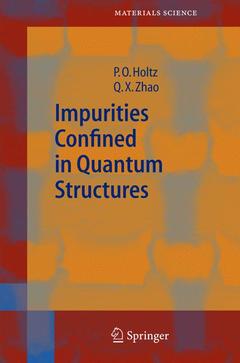Description
Impurities Confined in Quantum Structures, Softcover reprint of the original 1st ed. 2004
Springer Series in Materials Science Series, Vol. 77
Authors: Holtz Olof, Zhao Qing Xiang
Language: English
Subjects for Impurities Confined in Quantum Structures:
Impurities Confined in Quantum Structures
Publication date: 11-2012
139 p. · 15.5x23.5 cm · Paperback
Publication date: 11-2012
139 p. · 15.5x23.5 cm · Paperback
105.49 €
Subject to availability at the publisher.
Add to cart
Impurities Confined in Quantum Structures, (Series in materials science, Vol. 77)
Publication date: 08-2004
139 p. · 15.5x23.5 cm · Hardback
Publication date: 08-2004
139 p. · 15.5x23.5 cm · Hardback
Description
/li>Contents
/li>Comment
/li>
The dramatic impact of low dimensional semiconductor structures on c- rent and future device applications cannot be overstated. Research over the last decade has highlighted the use of quantum engineering to achieve p- viously unknown limits for device performance in research laboratories. The modi?ed electronic structure of semiconductor quantum structures results in transport and optical properties, which di?er from those of constituent bulk materials. The possibility to tailor properties, such as bandgap, strain, band o?set etc. , of two-dimensional (2D) semiconductors, e. g. quantum wells, for speci?c purposes has had an extensive impact on the electronics, which has resulted in a dramatic renewal process. For instance, 2D structures are today used in a large number of high speed electronics and optoelectronic appli- tions (e. g. detectors, light emitting diodes, modulators, switches and lasers) and in daily life, in e. g. LED-based tra?c lights, CD-players, cash registers. The introduction of impurities, also in very small concentrations, in a semiconductor can change its optical and electrical properties entirely. This attribute of the semiconductor is utilized in the manifoldness of their app- cations. This fact constitutes the principal driving force for investigation of the properties of the impurities in semiconductors. While the impurities in bulk materials have been investigated for a long time, and their properties are fairly well established by now, the corresponding studies of impurities in quantum wells is a more recent research area.
1 Introduction.- 2 Quantum Wells.- 3 Impurities in Bulk.- 4 Confined Neutral Donor States.- 5 The Negatively Charged Donor.- 6 Confined Acceptor States.- 7 The High Doping Regime.- 8 Hydrogen Passivation.- 9 Conclusions.- References.
Includes supplementary material: sn.pub/extras
© 2024 LAVOISIER S.A.S.
These books may interest you

Ultrawide Bandgap Semiconductors 236.94 €


